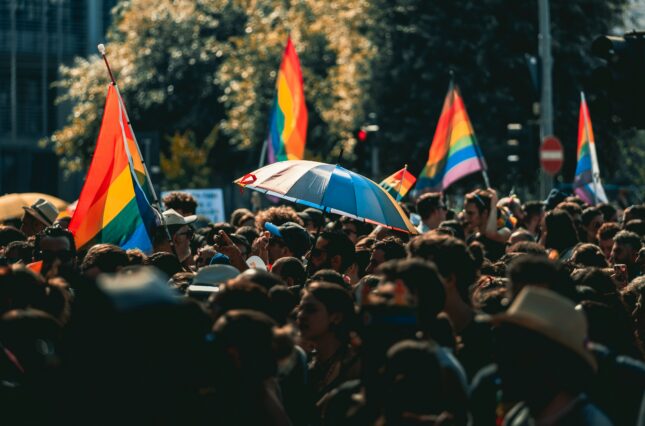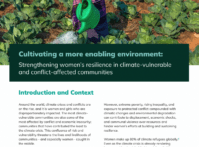-
Queering Climate Action: A Transformative Task
June 28, 2024 By Emily Dwyer
LGBTIQ+ organizations and activists increasingly speak of “queering” systems such as global climate action, global refugee systems, or humanitarian response. Sometimes, this is a rhetorical reboot of existing strategies for increasing inclusion, with ‘queer’ used as a reclaimed shorthand for LGBTIQ+ people. The process of tweaking existing social and economic systems to address climate change and security threats should also certainly ensure the inclusion of LGBTQI+ people.
Yet some proponents of queering have a more radical intent. They question whether the belated inclusion of LGBTQI+ people in stressed or broken systems is a sufficiently ambitious aim.
Take climate action. Some advocates of queering argue that settling for inclusion in such systems shortchanges everyone. A world in which temperature records are set month after month is a world that desperately needs transformative ideas beyond settling for “mak[ing] the best that we can” out of existing global climate change politics. Yet such queering does involve strategies that are easy to dismiss as utopic.
Precarity and Proximity
Many LGBTQI+ people around the world live in varying states of precarity. The consequences arising from the criminalization of aspects of LGBTQI+ people’s lives are one cause. Selective use of laws to harass LGBTQI+ people, or an absence of legal remedies are another factor. Discrimination within families, ostracism from family homes and consequent housing insecurity, play a role, as do schools and workplace discrimination that limits opportunities to develop economic resilience. LGBTQI+ people also may experience challenges accessing public and private services.
Precarity can be felt broadly by LGBTQI+ people. Those who are “out” may live with the heightened awareness of threats, while those who are not may live with an underlying fear of being outed against their will. Intersecting factors such as class, indigeneity and disability also may alleviate—or further exacerbate—precarity.
Alongside other drivers of political, social and economic instability, climate change can also create more complex webs of interactions for LGBTQI+ people. The underlying argument that “socially and economically disadvantaged and marginalized people are disproportionally affected by climate change” was developed in the Livelihoods and Poverty chapter of the Fifth Assessment Report in 2014. It was also articulated in frameworks that link multi-dimension inequality to exposure to climate hazards and increased damage from those exposures, as well as to decreased capability to cope and recover from the damage to lives that may result.
Research and debate amongst LGBTQI+ organizations has emerged to explore these interactions. For example, LGBTQI+ people living through slow-onset disasters such as droughts or rapid-onset disasters such as destructive storms often face specific challenges. First, pre-disaster precarity undermines opportunities for LGBTQI+ people to develop resilient lives and networks to withstand the impact of disasters and support their recovery.
Yet the discrimination, violence and exclusion that is present before a disaster strikes also continues during disaster responses. They may be felt through direct discrimination by some aid providers or by other community members—including violence in shelters. Other aid organization may fail to take steps to engage with LGBTQI+ people, or to understand their needs. LGBTQI+ people also may self-exclude based on justifiable fears that aid may be unsafe or lack relevance. New threats such as claims that LGBTQI+ people cause disasters—as divine punishment—also can emerge. And this inequitable access to recovery support may re-inscribe structural aspects of discrimination.
Tackling the Issues
It is still rare for global development, disaster risk reduction, or humanitarian processes to substantively engage with LGBTQI+ issues. These stakeholders offer little policy and practice guidance on detailed ways forward in specific thematic areas. Research is still needed to understand what current and emerging climate and security issues do require attention, but some early candidates for study are emerging:
- Access to clean drinking water. Activists in Bangladesh have already reported that gender-diverse hijra community members experience discrimination when accessing intermittently supplied public water points.
- Access to arable land, fishing grounds, forests and other agricultural resources. Literature reviews have highlighted absence of LGBTQI+ issues in agricultural research and extension services, while established linkages between gender-based violence, climate and agriculture also need to address discrimination, violence and exclusion experienced by LGBTQI+ people.
- Migration and forced displacement related to climate change. These challenges often occur within hostile contexts and in a system that is still learning how to be inclusive of LGBTQI+ people.
New policies such as USAID’s 2023 Inclusive Development Policy are important steps forward, but significant work to transform good intentions to actions still remains. Part of the tasks taken up by my own organization—Edge Effect—is to create tools for assessing and tracking progress on these fronts to ensure that LGBTQI+ inclusion is more than pinkwashing.
Taking the Next Steps
Some LGBTQI+ activists and allies question whether these actions are enough. LGBTQI+ activists challenge assumptions that undergird discrimination, violence and exclusion experienced by LGBTQI+ people. (For example, a broad assumption that we all are—or should be—heterosexual.)
Projects dedicated to the radical queering of climate justice situate struggles against these assumptions within analyses of the systems that lock in the status quo, artificially limit the range of options, and discredit or punish those who venture beyond those limits. The targets of this work include global systems that remain riven with neo-colonialism and racism, or that assume prosperity must be measured in GDP growth.
Some queer, feminist, First Nations and similar actors are exploring alternative models in specific areas such as urban planning. Others are providing funding that disrupts the aid system silos of regular development vs humanitarian crisis—a system born of a privileged worldview that sees crises as temporary blips in otherwise upward trajectories. These activists are equally concerned with pinkwashing and with greenwashing, and other related tendencies of systems to cop-opt rather than reform.
The aim of these activities is not to reinforce a binary choice between those who work within systems to reduce inequality and those working to create systems absent of inequalities. Indeed, queering involves a move away from hard ‘either/or’ choices and the embrace of ‘both/and’ continuums of tactics better suited to intervening in complex systems. So, wherever you sit politically, philosophically or geographically there is plenty to do before Pride month 2025!
Emily Dwyer is the co-founder and Chief Strategy Officer at Edge Effect, a global diverse SOGIESC (aka LGBTQI+) organization working to ensure that the humanitarian and development sectors address the rights, needs and strengths of people with diverse sexual orientations, gender identities and expressions, and sex characteristics (SOGIESC). Her work is centered on thematic areas including labor rights, social protection, WASH, disaster risk reduction and humanitarian response.
Sources: Devex; Edge Effect; Equality Fund; Guardian; IIED; IPCC; Journal of Refugee Studies; Outright International; Queers X Climate; Rainbow Railroad; UN; USAID; Water for Women Fund
Photo credit: People standing with pride flags, courtesy of Mick De Paola on Unsplash.
 A Publication of the Stimson Center.
A Publication of the Stimson Center.






